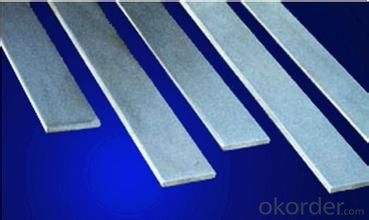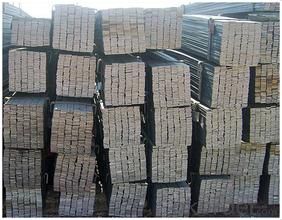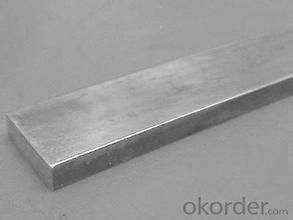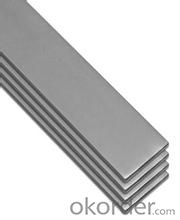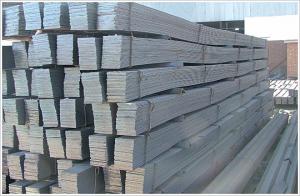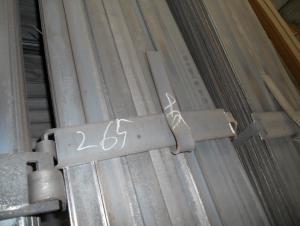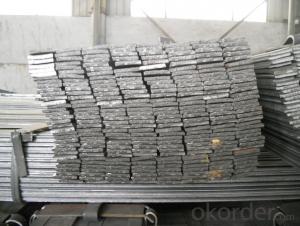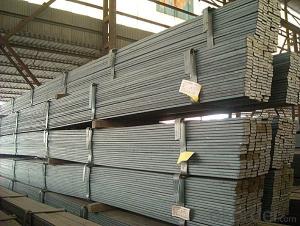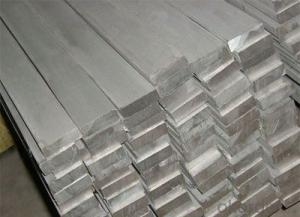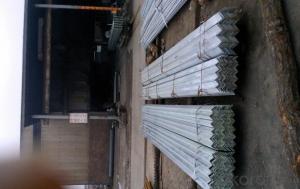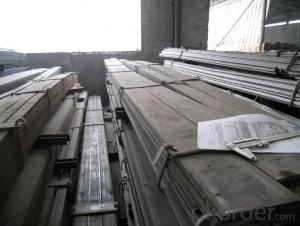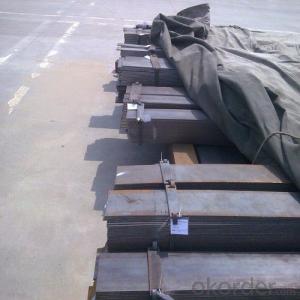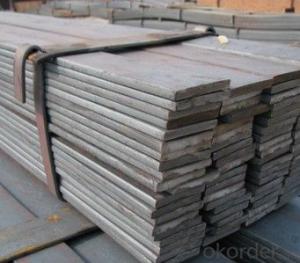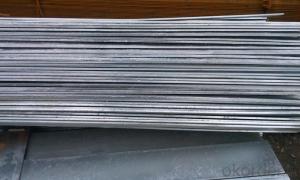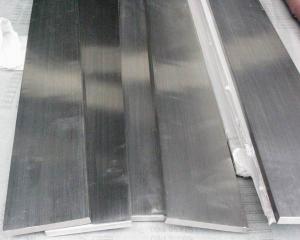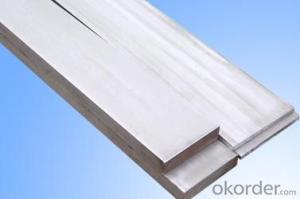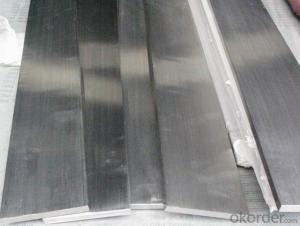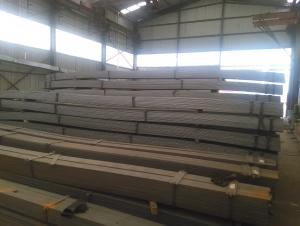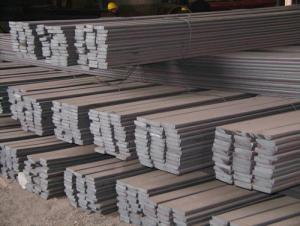Hot Rolled Wide Flat Steel 100mm*10mm*6m
- Loading Port:
- Tianjin
- Payment Terms:
- TT or LC
- Min Order Qty:
- 25 m.t.
- Supply Capability:
- 2000 m.t./month
OKorder Service Pledge
OKorder Financial Service
You Might Also Like
Product Description:
OKorder is offering Hot Rolled Wide Flat Steel 100mm*10mm*6m at great prices with worldwide shipping. Our supplier is a world-class manufacturer of steel, with our products utilized the world over. OKorder annually supplies products to European, North American and Asian markets. We provide quotations within 24 hours of receiving an inquiry and guarantee competitive prices.
Product Applications:
Hot Rolled Wide Flat Steel 100mm*10mm*6m are ideal for structural applications and are widely used in the construction of buildings and bridges, and the manufacturing, petrochemical, and transportation industries.
Product Advantages:
OKorder's Hot Rolled Wide Flat Steel 100mm*10mm*6m are durable, strong, and resist corrosion.
Main Product Features:
· Premium quality
· Prompt delivery & seaworthy packing (30 days after receiving deposit)
· Corrosion resistance
· Can be recycled and reused
· Mill test certification
· Professional Service
· Competitive pricing
Product Specifications:
Manufacture: Hot rolled
Grade: Q195 – 235
Certificates: ISO, SGS, BV, CIQ
Length: 6m – 12m, as per customer request
Packaging: Export packing, nude packing, bundled
Chinese Standard (H*W*T) | Weight (Kg/m) | 6m (pcs/ton) | Light I (H*W*T) | Weight (Kg/m) | 6m (pcs/ton) | Light II (H*W*T) | Weight (Kg/m) | 6M |
100*68*4.5 | 11.261 | 14.8 | 100*66*4.3 | 10.13 | 16.4 | 100*64*4 | 8.45 | 19.7 |
120*74*5.0 | 13.987 | 11.9 | 120*72*4.8 | 12.59 | 13.2 | 120*70*4.5 | 10.49 | 15.8 |
140*80*5.5 | 16.89 | 9.8 | 140*78*5.3 | 15.2 | 10.9 | 140*76*5 | 12.67 | 13.1 |
160*88*6 | 20.513 | 8.1 | 160*86*5.8 | 18.46 | 9 | 160*84*5.5 | 15.38 | 10.8 |
180*94*6.5 | 24.143 | 6.9 | 180*92*6.3 | 21.73 | 7.6 | 180*90*6 | 18.11 | 9.2 |
200*100*7 | 27.929 | 5.9 | 200*98*6.8 | 25.14 | 6.6 | 200*96*6.5 | 20.95 | 7.9 |
220*110*7.5 | 33.07 | 5 | 220*108*7.3 | 29.76 | 5.6 | 220*106*7 | 24.8 | 6.7 |
250*116*8 | 38.105 | 4.3 | 250*114*7.8 | 34.29 | 4.8 | 250*112*7.5 | 28.58 | 5.8 |
280*122*8.5 | 43.492 | 3.8 | 280*120*8.2 | 39.14 | 4.2 | 280*120*8 | 36.97 | 4.5 |
300*126*9 | 48.084 | 3.4 | 300*124*9.2 | 43.28 | 3.8 | 300*124*8.5 | 40.87 | 4 |
320*130*9.5 | 52.717 | 3.1 | 320*127*9.2 | 48.5 | 3.4 | |||
360*136*10 | 60.037 | 2.7 | 360*132*9.5 | 55.23 | 3 |
FAQ:
Q1: Why buy Materials & Equipment from OKorder.com?
A1: All products offered byOKorder.com are carefully selected from China's most reliable manufacturing enterprises. Through its ISO certifications, OKorder.com adheres to the highest standards and a commitment to supply chain safety and customer satisfaction.
Q2: How do we guarantee the quality of our products?
A2: We have established an advanced quality management system which conducts strict quality tests at every step, from raw materials to the final product. At the same time, we provide extensive follow-up service assurances as required.
Q3: How soon can we receive the product after purchase?
A3: Within three days of placing an order, we will begin production. The specific shipping date is dependent upon international and government factors, but is typically 7 to 10 workdays.
Q4: What makes stainless steel stainless?
A4: Stainless steel must contain at least 10.5 % chromium. It is this element that reacts with the oxygen in the air to form a complex chrome-oxide surface layer that is invisible but strong enough to prevent further oxygen from "staining" (rusting) the surface. Higher levels of chromium and the addition of other alloying elements such as nickel and molybdenum enhance this surface layer and improve the corrosion resistance of the stainless material.
Q5: Can stainless steel rust?
A5: Stainless does not "rust" as you think of regular steel rusting with a red oxide on the surface that flakes off. If you see red rust it is probably due to some iron particles that have contaminated the surface of the stainless steel and it is these iron particles that are rusting. Look at the source of the rusting and see if you can remove it from the surface.
Images:
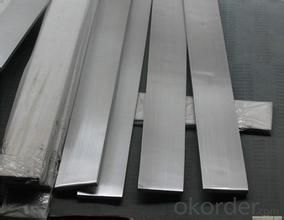
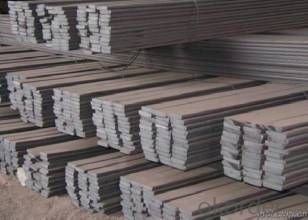
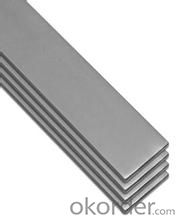
- Q: Are steel flat bars suitable for making architectural elements?
- Indeed, steel flat bars are well-suited for the creation of architectural elements. Steel, being a robust and long-lasting material, can be effortlessly molded and manipulated into a variety of designs and forms. The sleek and modern appearance of steel flat bars makes them highly sought-after for architectural elements like railings, handrails, door frames, and decorative features. Architectural applications benefit greatly from the advantages offered by steel flat bars. Firstly, their high tensile strength enables them to withstand heavy loads and provide structural stability, thus making them perfect for supporting and securing architectural elements. Secondly, steel flat bars possess remarkable versatility, as they can be easily cut, bent, and welded to create intricate designs and shapes. This flexibility empowers architects and designers to fabricate unique and customized elements that perfectly match the specific requirements and aesthetic preferences of a project. Moreover, steel flat bars exhibit corrosion resistance, rendering them suitable for both indoor and outdoor applications. This durability ensures that architectural elements crafted from steel flat bars will have an extended lifespan and require minimal maintenance. Aside from their functional properties, steel flat bars also possess an aesthetic appeal. The clean lines and sleek finish of steel flat bars can elevate the overall appearance of architectural elements, infusing a modern and contemporary touch into the design of a building. All in all, steel flat bars are an appropriate choice for the creation of architectural elements, owing to their strength, versatility, durability, and aesthetic appeal. Whether utilized for structural support, decorative features, or functional elements, steel flat bars provide a reliable and visually captivating solution for a multitude of architectural projects.
- Q: Can steel flat bars be used in the manufacturing of fencing or gates?
- Absolutely, steel flat bars are ideal for incorporating into the production process of fencing or gates. Possessing remarkable strength and durability, steel flat bars emerge as an exceptional option for crafting robust fences and gates capable of enduring diverse weather conditions and ensuring security. By welding or bolting these bars together, a stable and enduring framework can be established, guaranteeing stability and durability. Moreover, steel flat bars can be effortlessly manipulated and tailored to meet precise design specifications, enabling the development of one-of-a-kind fences and gates that are visually appealing.
- Q: Can steel flat bars be used for creating handrails or guardrails?
- Yes, steel flat bars can be used for creating handrails or guardrails. Steel flat bars are strong and durable, making them a suitable material for constructing handrails and guardrails. They have a smooth surface that provides a comfortable grip and can be easily shaped and welded to meet specific design requirements. Additionally, steel flat bars can withstand heavy loads and provide the necessary support and safety needed for handrails and guardrails.
- Q: Can steel flat bars be used for making staircases?
- Absolutely, staircases can indeed be constructed using steel flat bars. The strength and durability of steel flat bars make them a popular choice in the fields of construction and fabrication. They serve as an excellent primary structural element for staircases, ensuring reliable support and stability. Moreover, steel flat bars can be effortlessly manipulated and joined through welding to achieve the desired staircase design. Their corrosion resistance further enhances their suitability for indoor as well as outdoor staircases. All in all, steel flat bars offer versatility and dependability when it comes to staircase construction.
- Q: Can steel flat bars be drilled or tapped easily?
- Yes, steel flat bars can be drilled or tapped easily. Steel is a versatile material that can be machined using various tools and techniques. Drilling holes in steel flat bars can be done using a drill press or handheld drill with the appropriate drill bit. Similarly, tapping threads into steel flat bars can be achieved using a tap and die set. However, the ease of drilling or tapping may vary depending on the thickness and hardness of the steel. Thicker and harder steel bars may require more power and specialized tools for drilling or tapping. Additionally, using cutting fluids or lubricants can improve the ease and efficiency of the drilling or tapping process.
- Q: How do you protect steel flat bars from chemical exposure?
- To protect steel flat bars from chemical exposure, there are several measures you can take. 1. Coating: Applying a protective coating is one of the most effective ways to shield steel flat bars from chemical exposure. There are various types of coatings available, such as epoxy, polyurethane, or zinc-based coatings, that can provide a barrier between the steel and the chemicals. These coatings should be carefully selected based on the specific chemicals the steel will be exposed to and their compatibility with the coating material. 2. Galvanization: Galvanizing the steel flat bars can offer excellent protection against chemical exposure. This process involves coating the steel with a layer of zinc, which acts as a sacrificial barrier. When the steel comes into contact with chemicals, the zinc coating corrodes instead of the steel, preventing direct chemical attack. 3. Stainless steel: Using stainless steel flat bars, particularly those made from corrosion-resistant grades such as 316 or 304, can provide excellent resistance to chemical exposure. Stainless steel contains a minimum of 10.5% chromium, which forms a protective oxide layer on its surface, preventing corrosion by most chemicals. 4. Proper storage: Storing steel flat bars in a controlled environment can help minimize chemical exposure. Ideally, the storage area should be dry, well-ventilated, and free from any direct contact with corrosive substances. Additionally, proper stacking and separation of different materials can prevent chemical reactions and potential damage. 5. Regular maintenance: Regular inspection and maintenance are essential to ensure the continued protection of steel flat bars from chemical exposure. Any signs of coating damage or corrosion should be addressed promptly. Cleaning the surface using appropriate methods and products can help remove any chemical residues and maintain the integrity of the protective measures. It is important to note that the specific protective measures will depend on the type and concentration of chemicals the steel flat bars will be exposed to. Therefore, consulting with corrosion and material experts or referring to industry standards and guidelines can provide more tailored recommendations for protecting steel flat bars in a specific chemical environment.
- Q: Are steel flat bars resistant to fire?
- Generally, steel flat bars are resistant to fire. Steel, being a non-combustible material, does not burn or aid in the spread of fire. Due to its high melting point and excellent heat resistance, steel is highly resistant to fire. As a result, steel flat bars are commonly used in construction, manufacturing, and industrial settings where fire resistance is necessary. However, it is important to remember that while steel itself is fire-resistant, other materials attached to or surrounding the steel bars may not be. Therefore, it is crucial to consider the entire system and ensure that all components are fire-resistant to provide maximum fire protection.
- Q: What are the different bending techniques for steel flat bars?
- There are several bending techniques for steel flat bars, including cold bending, hot bending, and press braking. In cold bending, the bar is bent manually or using a machine without the need for heat. Hot bending involves heating the bar to a specific temperature and then shaping it using specialized tools or machines. Press braking is a technique that uses a hydraulic press to bend the bar to the desired angle.
- Q: Can steel flat bars be used for making shelving or storage units?
- Yes, steel flat bars can be used for making shelving or storage units. Steel flat bars are known for their durability and strength, making them an excellent choice for constructing shelving or storage units that need to hold heavy items or withstand frequent use. Additionally, steel flat bars can be easily welded or bolted together to create customized storage solutions that fit specific needs and spaces. The sleek and modern appearance of steel flat bars also adds an aesthetic appeal to shelving or storage units, making them suitable for both residential and commercial settings. Overall, steel flat bars provide a sturdy and reliable foundation for creating durable and functional shelving or storage units.
- Q: Can steel flat bars be used for manufacturing tools?
- Yes, steel flat bars can be used for manufacturing tools. Steel is known for its strength and durability, making it an ideal material for tool production. Steel flat bars can be easily shaped and machined to create various types of tools, such as wrenches, chisels, and scrapers. Additionally, steel's resistance to wear and corrosion ensures that the tools made from steel flat bars will have a longer lifespan and maintain their effectiveness over time.
Send your message to us
Hot Rolled Wide Flat Steel 100mm*10mm*6m
- Loading Port:
- Tianjin
- Payment Terms:
- TT or LC
- Min Order Qty:
- 25 m.t.
- Supply Capability:
- 2000 m.t./month
OKorder Service Pledge
OKorder Financial Service
Similar products
Hot products
Hot Searches
Related keywords





